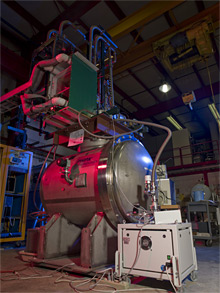Intensity Frontier
ArgoNeuT
The Argon Neutrino Teststand or ArgoNeuT detector, nicknamed for Jason and the Argonauts of Greek mythology, is a liquid argon neutrino detector at Fermilab. Argon is a noble, non-toxic element that in its gaseous form constitutes about 1 percent of air. It exists as a colorless liquid only in the narrow temperature range of minus 186 to minus 189 degrees Celsius.
Neutrinos passing through a large volume of argon can interact with an argon atom, producing secondary particles such as muons and protons, which then ionize other argon atoms. An electric field within the detector causes any charged particles to drift through the volume of argon, producing a breadcrumb trail of ionization electrons as they go.
Wireplanes collect the signals of the ionized particles. The position of the wires within the wireplanes, timing from scintillation light or elsewhere and the knowledge of the drift velocity of the ionization particles provides all the information needed for 3D reconstruction of the event.
Physicists hope that the experience of using the ArgoNeuT detector will prepare them to build a similar detector on a much larger scale. No one has ever built a multi-kiloton liquid-argon neutrino detector. One of the major challenges of building such a detector would be keeping a tank of liquid argon that large completely free of tiny impurities, which could ruin its effectiveness. Electronegative materials such as oxygen or water in the argon will combine with liberated electrons before they can drift to the wireplanes to be detected.
About 20 students, postdoctoral researchers and faculty from six institutions in the United States and Italy participate in the experiment. After building a second, larger detector called MicroBooNE, physicists eventually hope to build a 50,000-ton version of the detector to place in a proposed Deep Underground Science and Engineering Laboratory.



